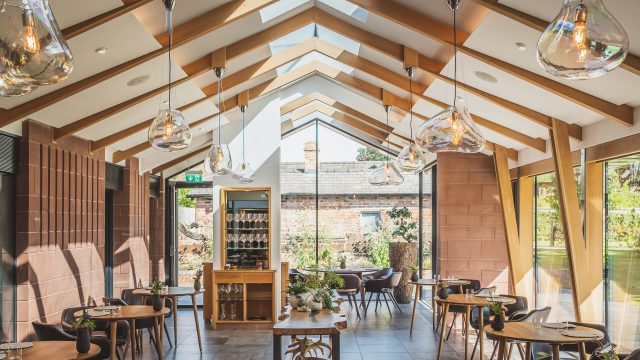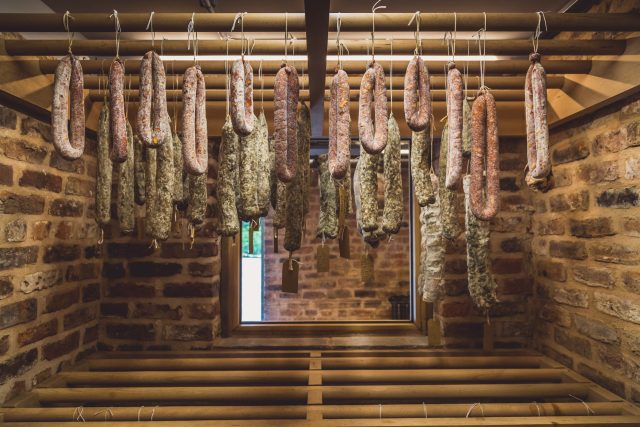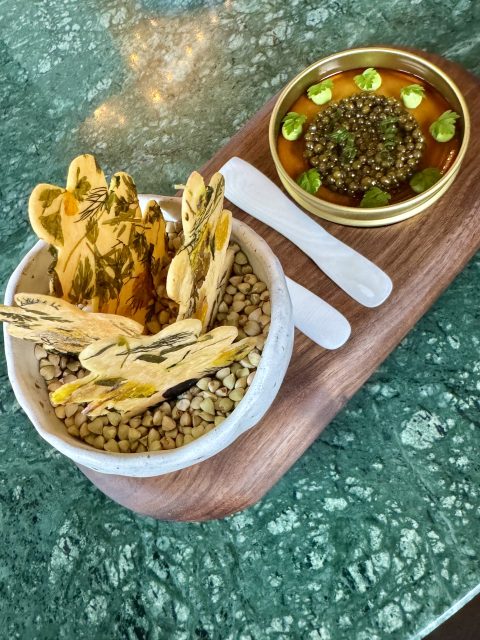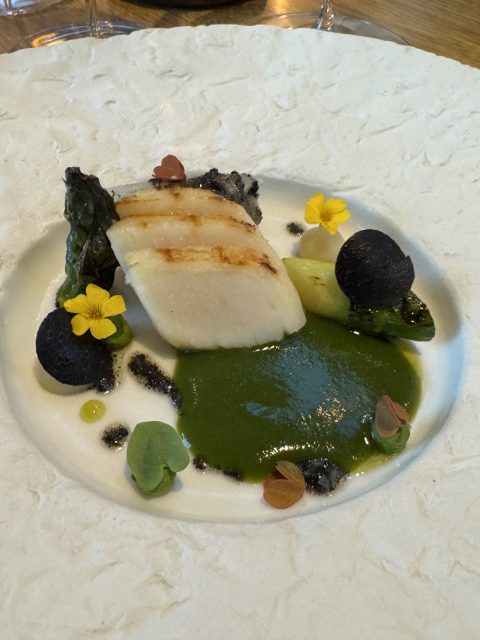This website uses cookies so that we can provide you with the best user experience possible. Cookie information is stored in your browser and performs functions such as recognising you when you return to our website and helping our team to understand which sections of the website you find most interesting and useful.
Wine List Confidential: Moor Hall
Douglas Blyde takes a trip to Lancashire’s Moor Hall to put the wine pairing options from head sommelier Matthew Davison through their paces.

“From the dazzling tasting menu to an epic breakfast, my favourite place to eat in the country right now,” appraised DJ turned design journalist and photographer, Mark C. O’Flaherty in The Telegraph of Moor Hall, which celebrated its seven-year anniversary in March, while editor of IndyEats Hannah Twiggs called it “a safe space for serious epicureans.”
Design
Rehabilitated by owner, Andy Bell, founder of AJ Bell investments and an Everton football club fanatic, Moor Hall’s chief allure is the near cleansing, contemporary Finnish chapel-like dining room replete with an enviably equipped open kitchen, glass-paned cellar and neighbouring cheese showroom. This is coupled to the original manor house, its exterior unnervingly fresh in finish, contrasting the reassuringly patina-rich interior, including an original dinky cooking range retained for ornamental purposes. During the day, the vast windows of the two Michelin-starred restaurant seize views of the remnants of a supposed seventeenth-century moat with burbling fountain, and, launching in July, one of seven garden lodges with hot tubs, meaning overspill overnight guests need no longer stay at the albeit well-rated Miller & Carter two miles west. Come dinner time, seats are turned inwards to face kitchen action.
A second eatery spans the rafters of the pastoral, one-Michelin-starred barn, featuring a three-course menu and North Brewing Co. pilsner on tap. A portion of its salvaged timbers have been tidily repurposed as the frame for a wisteria and hop-hugged pergola. At its base is a busy prep kitchen, the soon to be reinstated dairy for cheesemaking, and ageing rooms for both “Conrad’s charcuterie”, and guinea hens from the Landes.

Replete with a “stubborn” quince tree, the picture postcard, one-acre kitchen garden, which guests are guided through before dinner as fire pits are lit, is tended in a “no dig” fashion by the third-generation head gardener and avid rock climber, Catherine Butters, and her gardening duo. Hot houses brim with edible petals and what our fellow diner called “a motherload of micro shoots”, of which 100 trays are conveyed weekly to the kitchens. Works curated by local gallery, Castle Fine Art, flavour Moor Hall’s walls, including the at-a-push Warhol-like “Enduring Fab Four” (James Francis Gill) noting Liverpool is fewer than 12 miles south.
Although this is a destination venue with balletic service, to the soundtrack of Norah Jones and Jake Bugg, guests are encouraged to decompress at Moor Hall. One lady diner appeared to embrace the ambience as she joined her dinner companions on an adjacent table attired in what looked like couture-grade pyjamas.
Drinks
His hair almost iridescent, Matthew Davison, the Derbyshire-raised, Guinness-loving holder of a history degree, is both restaurant director and head sommelier, captaining a total of four sommeliers. Previously of Fischer’s at Baslow Hall which has a “Kitchen Tasting Bench”, and Restaurant Sat Bains with Rooms under Laurent Richet MS, Davison mentioned he recently reverted to offering Moor Hall’s 84-page wine list in printed form rather than tablet – much to his guests’ delight. This opens with an ode to “Provenance” – “The foundations of all great wine come down to the people, soil, quality of produce and patience.”

Options by the glass range from Sepp Moser’s textured Rohrendorf Bei Krems 2019 Grüner Veltliner (£15) to 2015 red Meursault from Coche-Dury (£95), via 2009 Maipo Bordeaux blend, Almaviva which James Suckling found “vertical” (£65), with Billecart-Salmon Brut Sous Bois NV being a choice champagne at £28.
By the bottle, effervescence begins at £80 for Recaredo Terrers Gran Reserva Brut Nature Corpinnat, ascending to Henri Giraud’s oak-fermented and matured 1993 Fût de Chêne at £750, being £20 more than Cristal 2009. Growers include Maurice Choppin’s 2017 spontaneously fermented, unfiltered, unfined L’Age et Raison from Damery (£145). Renditions of homegrown sparkling include Dermot Sugrue’s warm vintage The Trouble with Dreams 2018 (£150).
Still wines by the bottle open at £60, including a 2015 expression from Franconia pioneer of Scheurebe, Hans Wirsching, and Luigi Baudana and G.D Vajra’s 2022 “Dragon” Nascetta which perkily unites Sauvignon Blanc and Chardonnay and Riesling. For an extra tenner, interest broadens, with access granted to Chevassu-Fassenet 2020 Jura Chardonnay born of winemaker Marie-Pierre and her theatre director husband, Cédric Fassenet, the second wine of López de Heredia – 2015 Viña Cubillo Crianza, Listan Negro 2018 from Envinate, and Claus Preisinger’s hectic sounding Heideboden Zweigelt, Blaufränkisch and Merlot (2014). The list tops out at £7,500 for Romanée-Conti’s La Tâche 2008 (£7,500), representing a relatively modest £1,500 mark-up given the level at which Moor Hall unswervingly operates. In between, you will find Le Puy’s Emilien 2018, revered by manga fanatics (£105), Fontodi’s detailed Chianti Classico Gran Selezione Vigna del Sorbo 2016 (£160), and monolithic Latour 1998 (£1,200), Mouton 1995 (£1,400), Domaine Henri Bonneau Châteauneuf-du-Pape Réserve des Celestins 1988 (£2,100), and, beyond its retro label, Armand Rousseau Chambertin 2008 (£4,000).
Vivid cocktails include the “greenhouse gimlet” perfumed with Capreolus distillery’s awe-inspiring 1000 trees eaux de vie harvested from an orchard of 1,000 varieties, adorned with a hemp-like marigold leaf, and the Tokaji and Woodruff old fashioned enhanced with the 210g per litre of residual sugar, Dobogo 2017.
Glassware exemplifies the top-end catalogues of Riedel, Spiegelau, and Zalto.
Dishes
Formerly of the three Michelin-starred L’Enclume, the sixteen-strong brigade is directed by Mark Birchall in tandem with head chef, and keen cyclist, James Lovatt. The five-acre edible garden opposite is supplemented by a dedicated network of often local suppliers.
From the near scalpel-cut pastry of a slice of pork pie served with heart-fluttering leaf tea in a wheel-thrown Samuel Sparrow cup under the mulberry tree, to the breakfast honey harvested from one of a trio of on-site hives, every morsel devoured at Moor Hall showed rehearsed calibration, with emphasis always on flavour.
A tasting menu in bonsai form, canapés were served at malachite tables in the mullioned lounge. These included translucent, homemade British coppa, and peppered, gamey sika deer salami, sliced in our midst, and, harking to Birchall’s Lancashire roots, crisped pillows of back pudding with pickled gooseberry. “If Mark ever changes this one, I’ll seek medical opinion,” said Davison of the latter, which could have benefited with a dab more of the lifting Ribe. Almost invisible in taste, barbecued asparagus corseted chorizo and cured yolk, led to a long aftertaste. Skilfully sponge-like, a buttered muffin comprised near alive in freshness native lobster and homemade pancetta. Whipped cods roe with chicken, chervil, and aged, cob-nut-like kaluga caviar, was, with miniature caviar trowels, spread on dainty buckwheat “leaves”, impressed with herbs. The final canapé, smoked eel, potato, and fermented garlic, was dispensed by Birchall himself from an irregular octagon garden-like planter.

Perhaps noting the words of the Good Food Guide, that “some have felt that the wine flights are not quite as imaginative as they might be,” Davison chose to show his endeavours on both the esoteric “Prestige” (£145) and “Rarity” (£295) pairings, the latter drawing more deeply on older vintages.
To help the last drops of the gimlet evaporate, and presented almost like fried elvers, a dish of Cornish sea bream with preserved plum, kombu and radish, landed atop a nougat-like flower-pressed charger. A silken, eight-year-old, slow-cooked, helpfully sliced Louët-Feisser oyster swiftly ensued, with salt-baked white beetroots, succulent, cured, blow-torched lardo, and puffed quinoa. This was finished at table with a split sauce of dill and buttermilk.
Light of crumb, sliced linseed bread arrived with piped, lovage-dominated garden herb, and soured Jersey butters, the latter churned, solera-like, with a portion of older milk. At this stage, Davison explained his twosome of Mosel Rieslings to pair with royal oak rainbow carrots from nearby Doddington, with chrysanthemum, sea buckthorn, wild garlic pesto, and freshly shaved cheese “snow”. Not necessarily negatively, the liquid core of the dish evoked Baxter’s tomato soup, though sadly no spoon was supplied. The Prestige edgy, saline, 2017 Farhlay Marienberg Terrassen from fifth-generation Clemens Busch desolately trailed away in flavour here, while the Rarity, slightly spritzig 2020 lower alcohol Kabinett Scharzhofberger from Egon Müller’s eight hectares of vines, three of which persist in being ungrafted, effortlessly prevailed. “Length in wine is a seriously underrated factor in pairing,” noted Davison.
Of the next dish, white soy cooked Sweetbell turnip, Susan D’Arcy of The Times wrote, “You will never look at a turnip in the same way after tasting what Birchall can do to this humble root vegetable by adding crab, sunflower seeds and anise hyssop.” Davison chose an unconventional Albariño in the form of granite-grown, orange, beeswax-scented 2021 Forjas del Salnes Cos Pes, as well as the evolved, ripe, resinous Domaine Zind-Humbrecht’s Pinot Gris (2005). The viscosity and orange peel notes of the latter Rarity raised the dish, while the bracing nature of the former wine, one suspects, might better have dovetailed with the carrot dish of before.
An original dish from opening day, ancient breed beef, Ruby Red tartare was seamlessly woven with barbecued Pablo beetroot, mustard, shallot, and burnt onion ash. Although aged for 80 days, the lamentably micro portion of beef was gorged in sixty seconds. With this, Davison poured the Frazzles-scented 2018 Pedro Parra Cinsault from Chile’s southerly Itata Valley, which evoked, he said, “the smell of Etienne Sauzet white Burgundy”, and bore the name “Trane” in honour of saxophonist, John Coltrane. This Prestige pairing was more agile than the old-school, plush, slightly saggy 2006 Langoa-Barton from the Rarity line-up, being one of Davison’s favourite Bordeaux estates. “It’s nice to see Cinsault taken seriously,” he said of the compelling, old bush vine Parra, which had abundant verve to cope with the caper components of the dish. “My jaw didn’t leave the floor when I first tried it,” he later added on seeing our enjoyment of the standout dish.
With the natural sweetness of diver-caught Isle of Mull scallop, charred, then sliced like steak, with fermented grains, a pool of green tomato sauce, asparagus, and discreet of flavour, truffle discs, accompanied by an entire overkill but pretty steak knife, Davison reverted to white. Reaped from the very vineyard which yields Eben Dadie’s mighty Skerpioen, AA Badenhorst’s celebrated saline, citrusy Sout van die Aarde coastal Palomino (2019) entered play with Pierre-Yves Coline-Morey’s La Chateniere, from an 0.86-hectare parcel of Saint-Aubin. It was harvested in 2012, “so it escaped the premox era” said Davison. Despite impressive credentials, it performed with the enthusiasm of one forcefully awakened during the deep REM cycle, frustratingly connoting the second loss in a row for the Prestige pairing.

Davison chose two champagnes of equal dosage (4g/l) next: Michel Gonet’s almost Volvo reliable, nougat-scented, though linear of palate, 3 Terroirs Blanc de Blancs from 2019, and Billecart-Salmon’s Pinot Noir-led, Grand Cru Rolls, 2002 Nicolas François, named after the Maison’s co-owner (1818). Meltingly luxurious and fortunately fizzy, Davison noted said such high-quality champagne even tastes good “when flat”. These accompanied remarkable line-caught, grilled Cornish turbot with pickled pear, a particularly skilful mussel mousse, impactful dots of salsify purée, umami to the fore smoked pike roe and Oscietra caviar sauce, and a Chinese artichoke which evoked, in appearance, an amputated arm of Bibendum, the Michelin mascot. Although the toasty, Billecart from Rarity was the clear fscourite, the prism-like Gonet was not redundant, acting like a syringe of citrus. Given the ascent of English sparkling wines, including genuinely parcellaire expressions which are not exactly strangers at equivalent three Michelin star venues these days, we did pause to ponder why Davison chose not to consider showing a world-class homegrown, non-malolactic expression in its place, however.
It was time for the organic, corn, then milk-fed guinea hen, which had waited in the wings of Moor Hall’s ageing room for ten days, to take to the stage. Having passed muster when presented for inspection on a herby slate, the bird was served over three movements, first as opulent leg meat and offal ragu with salsa verde, choucroute, and whey foam, then as tender breast, with wild garlic stuffed morel, white asparagus foam, elderflower vinegar and Vin Jaune. Gilding the lily, we were encouraged to spread a foie gras parfait which our companion described as “so light it made me feel less full” with Moor Hall honey over a fine, swirled, onion roll. Here, Davison pulled focused on Pinot Noir, pitching a magnum of cheery, lactic, high-hitter 2016 “Village” Bannockburn from Felton Road, versus the triumphant Domaine Arnoux-Lachaux’s masterly, floral, then dark of spice, 2008 Latricieres-Chambertin.
Segueing to the sweet act, it is worth noting Birchall spurns chocolate. “We do get chicken foot quite a bit,” said Davison of Ormskirk gingerbread, with roots and pine, which was actually intended to aesthetically resemble ginger root. Next, compressed rhubarb from Tomlinsons of Pudsey was draped like a big top tent over young Ragstone goat cheese with persistent blood orange and lemon verbena sorbet. Here, Davison poured luscious, winning 2021 Inniskillin ice Riesling from Canada and, from magnum, Marie-Therese’s Chappaz Grain Noble, noted on the menu as non-vintage. Reaped from barely accessible, frontier Marsanne, Petite Sarine, and Pinot Gris, tugging into steep terraces in Switzerland’s Valais, the drier wine has “no added anything” according to its fans. Although a “Rarity”, this 100% interesting bottle struck us as potentially more aligned with the more left-of-field “Prestige” category.
Finally, a crown-like arrangement of garden apples and gooseberry on a woodruff-scented mousse was lapped by a ring of birch sap dressing. Davison poured Fontodi’s vital 2013 Vin Santo, crafted from patiently air-dried Malvasia and Sangiovese raisins. The result was “Easter in a glass” said Davison. Representing the Rarity, Klein Constancia’s Vin de Constance 2005 is “one of the greatest, though least talked about” sweet wines, he said. Although both wines were on par in quality, the Fontodi had munificence, and even continued to please through to the finale of blackcurrant with sour cream and anise, dabbed with honey, and served under the pargeting and chandeliers of the lounge.
Last word
To have reviewed in this detail, having burst the dam of the word count, may come across as an overshare akin to a slide show of holiday photos. With four Michelin stars already – two for the restaurant, one for the barn, and a green one to highlight sustainable practices – Moor Hall is already a must on the dance card of restaurant-goers. From roots to micro shoots, this beacon is lit to coax the guide’s full attention, and as the team guides the dining room to the victorious third star, now is an optimal moment to visit. Often at this echelon, restaurants refine, rather than relentlessly originate, a scenario which could have the benefit of prompting Davison to push the vinous frontiers even further.
Best for
- Edible garden
- Well trained team
- Classic wines interspersed with rarer esoterica
Value: 92.5, Size: 95, Range: 94.5, Originality: 94, Experience: 99; Total: 95
Moor Hall – Prescot Road, Aughton, Lancashire, L39 6RT; 01695 572511; enquiry@moorhall.com; moorhall.com
Related news

